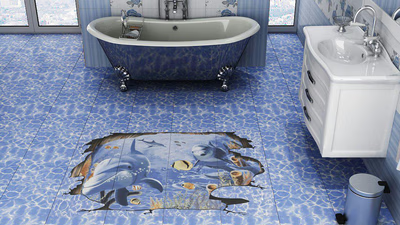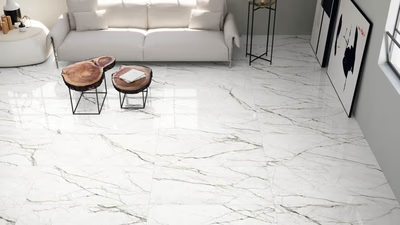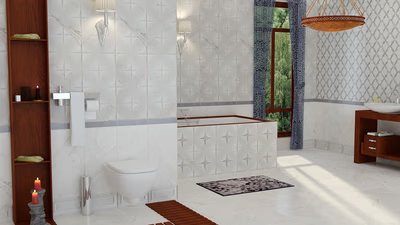
Explore high-quality ceramic tiles for your projects.
The quality of the materials used and the manufacturing process employed can impact the price and quality of ceramic tiles. Higher-quality tiles are typically made from finer clay or other premium materials, resulting in a more durable and aesthetically pleasing product. Tiles manufactured using advanced techniques and technologies may also command a higher price due to improved precision and consistency. Thicker tiles are generally considered to be of higher quality as they tend to be more durable and resistant to cracking or breaking. Thinner tiles may be more affordable but can be prone to damage under heavy use or stress. The strength of the tile is an essential factor to consider when assessing quality.
The surface finish of ceramic tiles can vary, ranging from matte to glossy. A high-quality tile will have a consistent and well-applied finish, ensuring durability and resistance to stains and wear. Glossy tiles may require additional glazing or protective coatings, which can increase their price. Intricate designs, patterns, and unique colors can contribute to the price of ceramic tiles. Tiles with more complex and detailed designs often require specialized production techniques, resulting in a higher price. Additionally, premium tiles may offer a wider range of design options, allowing for greater customization.
As we know, beautiful and high-quality ceramic tiles are one of the essentials of any building, but it is important to note that although choosing a high-quality and eye-catching product is very important, the price of the selected ceramic tiles should be based on the quality. Durability, brand name and manufacturing company should match and do not buy it at any price because you have simply wasted your money. Ceramic tile is a durable option for kitchen flooring that maintains its timeless beauty and has the lowest life cycle cost of any flooring. This means it is less expensive to maintain per year (least likely to need replacement or repair) than other kitchen flooring options, including vinyl, wood, cork and laminate. It also means you won't have to worry about replacing your tiles anytime soon. Just take a look at how tile has been used over the centuries to get an idea of its incredible longevity.
If you are a construction manufacturer or you operate as a seller of sanitary and construction supplies, it is better to buy the products you need directly from the manufacturing factories. Buying ceramic tiles from the factory, in addition to saving your purchase amount, will also diversify your shopping cart. Because you can buy more diverse products from a ceramic tile factory. Since ceramic tiles are one of those building materials that are used in the final stages of building construction and we may worry about the budget needed to buy these products, so we should use our remaining budget efficiently and tile. And we should buy the ceramics of our building from major sales centers or the main agencies of that brand, because with this method other middlemen are removed and we get their real price.
If we look optimistically, after the production of ceramic tiles in the manufacturing factories, the volume of production of each design will be placed in the inventory list of the factory, and the representatives will reserve and buy them, and according to the schedule of the factory, by means of freight The parties to the contract are declared loaded and transported by truck to the agents' warehouse in their city.
Higher-quality ceramic tiles are typically more durable and long-lasting, with better resistance to wear, moisture, and stains. They may also have additional properties such as slip resistance or thermal efficiency. These performance attributes can affect the price of the tiles. Established brands with a reputation for producing high-quality ceramic tiles often command higher prices. These brands have invested in research, development, and quality control measures to ensure their products meet certain standards. However, it's important to note that lesser-known or newer brands can also offer quality tiles at a more competitive price.
-

The price and quality of ceramic tiles are influenced by the materials used and the manufacturing processes. Higher-quality tiles, made from premium clay and advanced techniques, tend to be more durable and visually appealing. Thicker tiles are generally more robust, while thinner options may be more affordable but less durable. The surface finish, ranging from matte to glossy, also affects pricing; high-quality finishes ensure longevity and resistance to stains. Intricate designs and unique colors can increase costs due to specialized production methods. While aesthetic appeal is important, buyers should prioritize quality over price to avoid wasting money on inferior products. Ceramic tiles are a cost-effective flooring option for kitchens due to their durability and low maintenance costs compared to alternatives like vinyl or wood. For construction manufacturers or suppliers, purchasing directly from factories can lead to cost savings and a wider selection of products.
By eliminating middlemen, buyers can access better prices for ceramic tiles. Established brands often command higher prices due to their reputation for quality, but newer brands may offer competitive options without compromising on standards. Overall, understanding the factors that influence tile pricing can help consumers make informed decisions.
-

Ceramic tiles are made from clay and inorganic materials, fired at high temperatures, making them durable and versatile for various applications. They are commonly used in residential and commercial settings for flooring and wall coverings due to their aesthetic appeal and ease of maintenance. The manufacturing process involves shaping clay into tiles and firing them in kilns, resulting in a strong product that is resistant to water, stains, and scratches. Ceramic tiles can last many years with proper care, making them a popular choice for both functional and decorative purposes. They come in various shapes, sizes, colors, and patterns, offering extensive design options. Glazed ceramic tiles feature a protective glass layer for added durability, while unglazed tiles provide slip resistance suitable for wet areas. The historical significance of ceramic tiles dates back to 4000 BC in Egypt, highlighting their long-standing role in architecture. Their importance extends beyond aesthetics; they also contribute to environmental health by preventing moisture penetration.
-

Ceramic tiles are versatile materials widely used in both residential and commercial settings due to their durability, moisture resistance, and aesthetic appeal. They are ideal for high-traffic areas like kitchens, bathrooms, and entryways. In addition to flooring, ceramic tiles serve as wall coverings, countertops, and decorative elements in various spaces. Their chemical resistance makes them suitable for industrial applications as well. The lightweight nature of ceramic slabs reduces the structural load on buildings while allowing for diverse design options. Digital printing technologies enable the creation of unique patterns and textures, enhancing their visual appeal. Hygienic properties further contribute to their popularity over other materials like stone or cement. With a vast array of colors and designs available, ceramic tiles can be tailored to meet individual preferences in both traditional and modern architecture.
They are also used outdoors in patios and pool areas due to their weather-resistant qualities. Overall, ceramic tiles offer a combination of functionality and style that makes them a preferred choice in construction projects across the Middle East.
-

Ceramic tile production involves several key processes, starting with the selection and processing of raw materials such as clay, feldspar, and quartz. These materials are blended in precise proportions to create a homogeneous mixture. The forming process can be achieved through dry pressing or extrusion, shaping the tiles into their desired forms. After forming, tiles undergo drying to eliminate moisture, followed by glazing to enhance appearance and functionality. Glazing is applied using various methods and provides a protective finish. The critical firing process transforms the raw ceramic into a durable structure at high temperatures ranging from 1,000 to 2,500 degrees Fahrenheit. This step is essential for achieving the desired strength and color of the tiles. Post-firing, tiles are inspected for quality control, ensuring dimensional accuracy and surface integrity.
Any defective pieces are discarded before the final cutting and edge treatment processes are performed to prepare them for installation. Finally, tiles are packaged securely for transportation. The production of ceramic tiles is influenced by technological advancements that improve efficiency and quality.
-

Ceramic tiles have a rich history dating back to ancient Mesopotamia around 4,000 BCE, where they were used for decorative purposes. Ancient Egyptians also utilized tiles adorned with colorful designs in tombs and palaces. The Greeks and Romans advanced tile art, using them for mosaics and in public buildings. The Islamic Golden Age saw the emergence of intricate geometric patterns and Arabic calligraphy in tile designs, particularly the blue and white "azulejos. " The Renaissance period revived ceramic tile production in Europe with new techniques like maiolica. In the Middle East, the tile industry transitioned from manual production to modern factories by the mid-1930s, significantly boosting exports. Iran"s ceramic industry ranks sixth globally, contributing to its economy through foreign currency earnings. The Industrial Revolution further mechanized tile production, making it more accessible.
Today, advancements in technology allow for diverse designs and finishes in ceramic tiles. "
-

Ceramic tiles offer numerous advantages, making them a popular choice for flooring and wall coverings. Their durability allows them to withstand heavy foot traffic and resist scratches, ensuring longevity when properly maintained. They are water-resistant, making them ideal for moisture-prone areas like kitchens and bathrooms, while their non-porous surface prevents mold and mildew growth. Easy maintenance is another key benefit; regular cleaning requires minimal effort. The variety of sizes, shapes, colors, and patterns available allows for versatile design options that can suit any aesthetic preference. Additionally, ceramic tiles are hygienic as they do not harbor allergens or bacteria, making them suitable for individuals with allergies or respiratory issues. They are free from harmful substances such as VOCs, formaldehyde, and PVC, contributing to a healthier indoor environment. Their excellent heat resistance makes them safe around high-temperature areas without emitting toxic fumes.
Furthermore, ceramic tiles can enhance energy efficiency due to their thermal conductivity properties. Overall, the combination of durability, low maintenance needs, aesthetic versatility, and health benefits positions ceramic tiles as an excellent flooring option in various settings.






